Operations Management Principles Review and Critique: Marks & Spencer
VerifiedAdded on 2023/06/18
|23
|5921
|169
Report
AI Summary
This report provides a comprehensive review and critique of operations management principles within Marks & Spencer. It begins with an introduction to the organization and an explanation of the difference between operation and operations management. The report then reviews and critiques the implementation of operations management principles, analyzing the extent to which the organization's operations management meets its requirements. It discusses continuous improvement as a philosophy, describes Lean principles, and presents a continuous improvement plan with justified recommendations. Key aspects covered include Taylor's Theory of Scientific Management, Kaizen, Six Sigma, and various improvement methodologies such as quality circles, benchmarking, TQM, SCM, and ERP. The report concludes with a summary of the key findings and recommendations for enhancing operational efficiency and effectiveness at Marks & Spencer. Desklib provides access to similar solved assignments and study resources for students.

ID
Unit Number and Title Unit 187 – Operations and Project Management
Title Review and Critique of Operations Management (Part 1)
Project Life Cycle (Part 2)
0
Unit Number and Title Unit 187 – Operations and Project Management
Title Review and Critique of Operations Management (Part 1)
Project Life Cycle (Part 2)
0
Paraphrase This Document
Need a fresh take? Get an instant paraphrase of this document with our AI Paraphraser
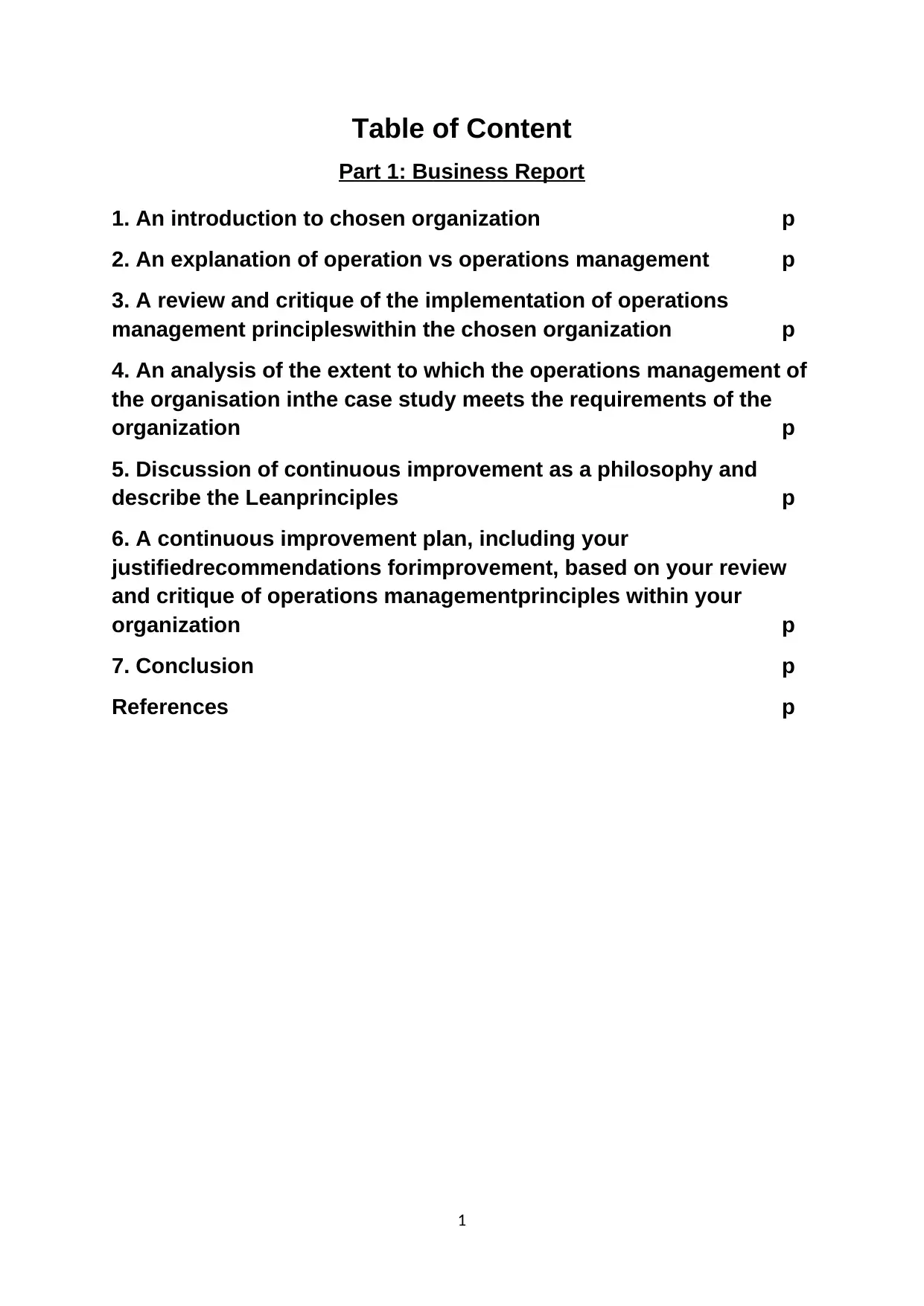
Table of Content
Part 1: Business Report
1. An introduction to chosen organization p
2. An explanation of operation vs operations management p
3. A review and critique of the implementation of operations
management principleswithin the chosen organization p
4. An analysis of the extent to which the operations management of
the organisation inthe case study meets the requirements of the
organization p
5. Discussion of continuous improvement as a philosophy and
describe the Leanprinciples p
6. A continuous improvement plan, including your
justifiedrecommendations forimprovement, based on your review
and critique of operations managementprinciples within your
organization p
7. Conclusion p
References p
1
Part 1: Business Report
1. An introduction to chosen organization p
2. An explanation of operation vs operations management p
3. A review and critique of the implementation of operations
management principleswithin the chosen organization p
4. An analysis of the extent to which the operations management of
the organisation inthe case study meets the requirements of the
organization p
5. Discussion of continuous improvement as a philosophy and
describe the Leanprinciples p
6. A continuous improvement plan, including your
justifiedrecommendations forimprovement, based on your review
and critique of operations managementprinciples within your
organization p
7. Conclusion p
References p
1
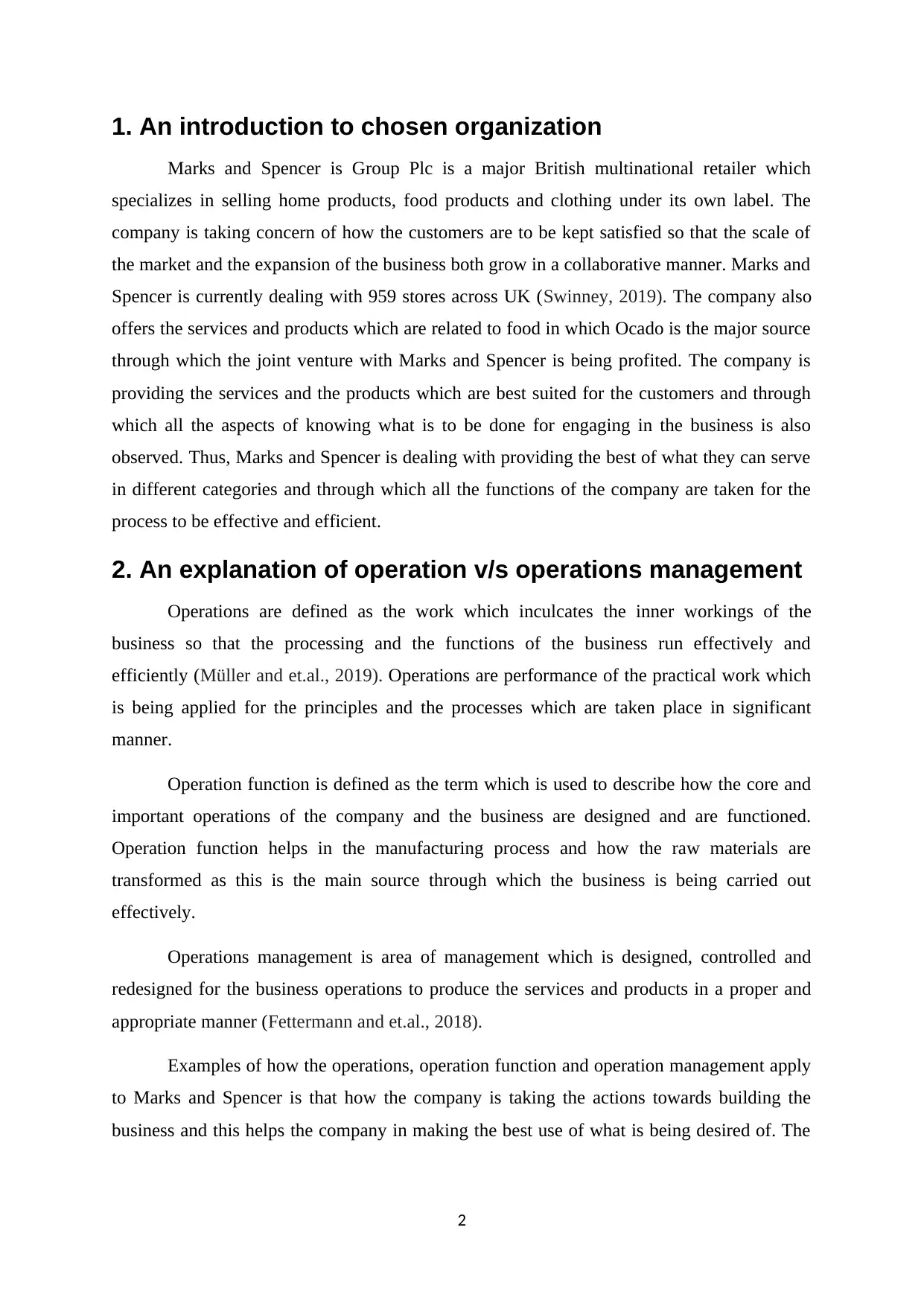
1. An introduction to chosen organization
Marks and Spencer is Group Plc is a major British multinational retailer which
specializes in selling home products, food products and clothing under its own label. The
company is taking concern of how the customers are to be kept satisfied so that the scale of
the market and the expansion of the business both grow in a collaborative manner. Marks and
Spencer is currently dealing with 959 stores across UK (Swinney, 2019). The company also
offers the services and products which are related to food in which Ocado is the major source
through which the joint venture with Marks and Spencer is being profited. The company is
providing the services and the products which are best suited for the customers and through
which all the aspects of knowing what is to be done for engaging in the business is also
observed. Thus, Marks and Spencer is dealing with providing the best of what they can serve
in different categories and through which all the functions of the company are taken for the
process to be effective and efficient.
2. An explanation of operation v/s operations management
Operations are defined as the work which inculcates the inner workings of the
business so that the processing and the functions of the business run effectively and
efficiently (Müller and et.al., 2019). Operations are performance of the practical work which
is being applied for the principles and the processes which are taken place in significant
manner.
Operation function is defined as the term which is used to describe how the core and
important operations of the company and the business are designed and are functioned.
Operation function helps in the manufacturing process and how the raw materials are
transformed as this is the main source through which the business is being carried out
effectively.
Operations management is area of management which is designed, controlled and
redesigned for the business operations to produce the services and products in a proper and
appropriate manner (Fettermann and et.al., 2018).
Examples of how the operations, operation function and operation management apply
to Marks and Spencer is that how the company is taking the actions towards building the
business and this helps the company in making the best use of what is being desired of. The
2
Marks and Spencer is Group Plc is a major British multinational retailer which
specializes in selling home products, food products and clothing under its own label. The
company is taking concern of how the customers are to be kept satisfied so that the scale of
the market and the expansion of the business both grow in a collaborative manner. Marks and
Spencer is currently dealing with 959 stores across UK (Swinney, 2019). The company also
offers the services and products which are related to food in which Ocado is the major source
through which the joint venture with Marks and Spencer is being profited. The company is
providing the services and the products which are best suited for the customers and through
which all the aspects of knowing what is to be done for engaging in the business is also
observed. Thus, Marks and Spencer is dealing with providing the best of what they can serve
in different categories and through which all the functions of the company are taken for the
process to be effective and efficient.
2. An explanation of operation v/s operations management
Operations are defined as the work which inculcates the inner workings of the
business so that the processing and the functions of the business run effectively and
efficiently (Müller and et.al., 2019). Operations are performance of the practical work which
is being applied for the principles and the processes which are taken place in significant
manner.
Operation function is defined as the term which is used to describe how the core and
important operations of the company and the business are designed and are functioned.
Operation function helps in the manufacturing process and how the raw materials are
transformed as this is the main source through which the business is being carried out
effectively.
Operations management is area of management which is designed, controlled and
redesigned for the business operations to produce the services and products in a proper and
appropriate manner (Fettermann and et.al., 2018).
Examples of how the operations, operation function and operation management apply
to Marks and Spencer is that how the company is taking the actions towards building the
business and this helps the company in making the best use of what is being desired of. The
2
⊘ This is a preview!⊘
Do you want full access?
Subscribe today to unlock all pages.

Trusted by 1+ million students worldwide

operations, operation function and operation management works in the company which helps
in benefitting the business on large scale (Ivanov and et.al., 2017).
3. A review and critique of the implementation of
operations management principles within the chosen
organization
In operation management process there are some strengths and limitations which are being
considered as important which are explained as –
Strengths – The operation management process helps in reviewing the scale through which
the processes and the systems of the operations management for the products and services to
be delivered to the customers are provided in an effective and efficient way (Choi and et.al.,
2018).
Limitations – The operation management process is a complex process which increases the
human error and the multi- level dependency which creates problem for the organization.
The operations management principles for Marks and Spencer is defined through the
Taylor’s Theory of Scientific Management which are described below –
Taylor’s Theory of Scientific Management – There are 14 principles of scientific
management which are –
Science, Not Rule of Thumb – This principle states to not get stuck in the old
techniques of performing the tasks and the work.
Harmony, Not Discord – There should be harmony in the organization which should
be followed by the employees and the management of company (Mouzelis, 2017).
Cooperation, Not Individual – This principle explains that tasks in the organization
should be carried out with the collaboration of different individuals which helps in
accomplishing the goals.
Development of each and every individual with greatest effectiveness and efficiency
– Efficiency of the individuals are to be taken care of with the help of training of the
individuals and the employees of the organization (Mouzelis, 2017).
These factors lead to mass customization, flexible specialization, agile manufacturing, lean
production which helps the organization in making the scale effective and efficient for which
all the aspects are being considered and the operations of the company are in order.
3
in benefitting the business on large scale (Ivanov and et.al., 2017).
3. A review and critique of the implementation of
operations management principles within the chosen
organization
In operation management process there are some strengths and limitations which are being
considered as important which are explained as –
Strengths – The operation management process helps in reviewing the scale through which
the processes and the systems of the operations management for the products and services to
be delivered to the customers are provided in an effective and efficient way (Choi and et.al.,
2018).
Limitations – The operation management process is a complex process which increases the
human error and the multi- level dependency which creates problem for the organization.
The operations management principles for Marks and Spencer is defined through the
Taylor’s Theory of Scientific Management which are described below –
Taylor’s Theory of Scientific Management – There are 14 principles of scientific
management which are –
Science, Not Rule of Thumb – This principle states to not get stuck in the old
techniques of performing the tasks and the work.
Harmony, Not Discord – There should be harmony in the organization which should
be followed by the employees and the management of company (Mouzelis, 2017).
Cooperation, Not Individual – This principle explains that tasks in the organization
should be carried out with the collaboration of different individuals which helps in
accomplishing the goals.
Development of each and every individual with greatest effectiveness and efficiency
– Efficiency of the individuals are to be taken care of with the help of training of the
individuals and the employees of the organization (Mouzelis, 2017).
These factors lead to mass customization, flexible specialization, agile manufacturing, lean
production which helps the organization in making the scale effective and efficient for which
all the aspects are being considered and the operations of the company are in order.
3
Paraphrase This Document
Need a fresh take? Get an instant paraphrase of this document with our AI Paraphraser
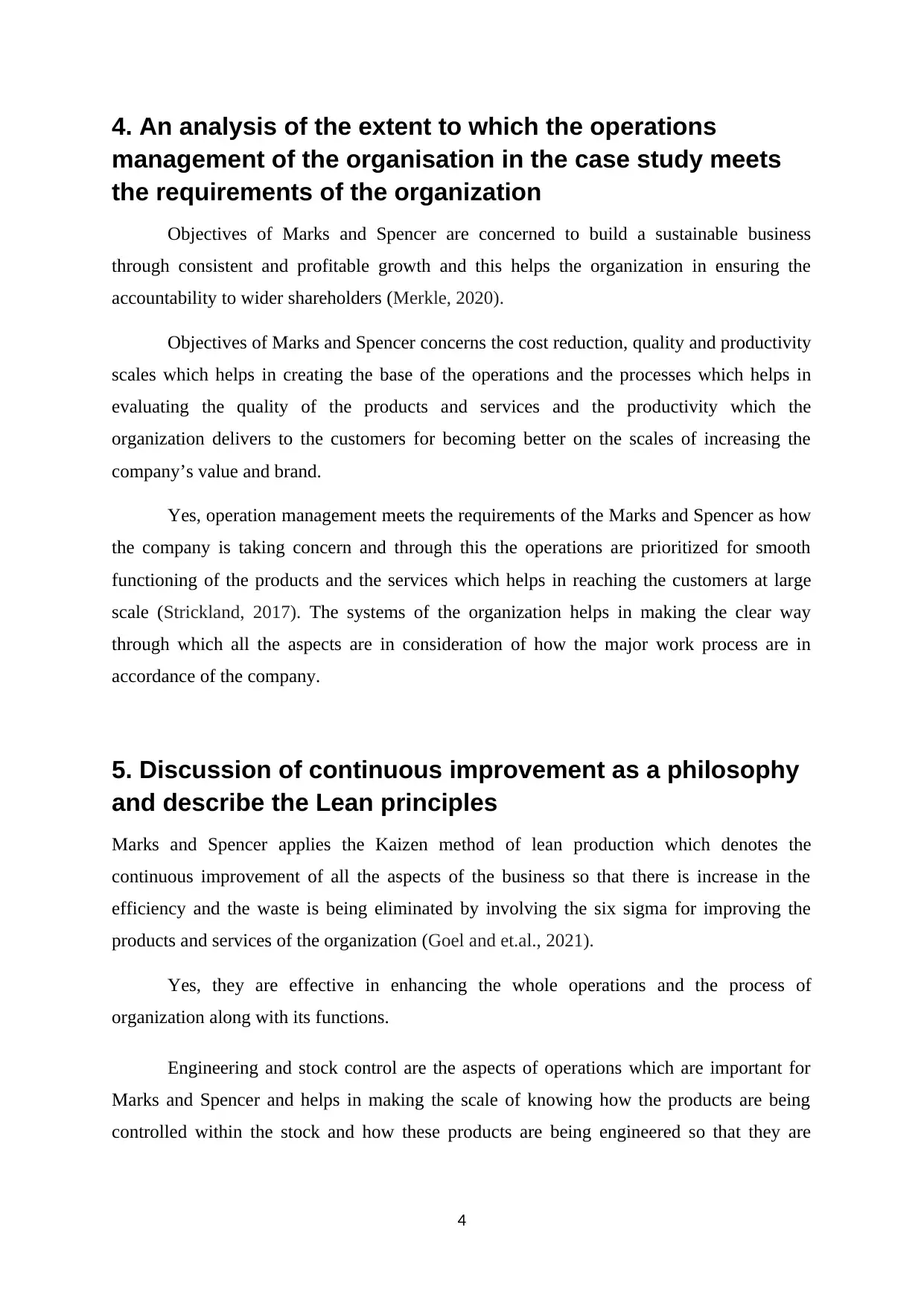
4. An analysis of the extent to which the operations
management of the organisation in the case study meets
the requirements of the organization
Objectives of Marks and Spencer are concerned to build a sustainable business
through consistent and profitable growth and this helps the organization in ensuring the
accountability to wider shareholders (Merkle, 2020).
Objectives of Marks and Spencer concerns the cost reduction, quality and productivity
scales which helps in creating the base of the operations and the processes which helps in
evaluating the quality of the products and services and the productivity which the
organization delivers to the customers for becoming better on the scales of increasing the
company’s value and brand.
Yes, operation management meets the requirements of the Marks and Spencer as how
the company is taking concern and through this the operations are prioritized for smooth
functioning of the products and the services which helps in reaching the customers at large
scale (Strickland, 2017). The systems of the organization helps in making the clear way
through which all the aspects are in consideration of how the major work process are in
accordance of the company.
5. Discussion of continuous improvement as a philosophy
and describe the Lean principles
Marks and Spencer applies the Kaizen method of lean production which denotes the
continuous improvement of all the aspects of the business so that there is increase in the
efficiency and the waste is being eliminated by involving the six sigma for improving the
products and services of the organization (Goel and et.al., 2021).
Yes, they are effective in enhancing the whole operations and the process of
organization along with its functions.
Engineering and stock control are the aspects of operations which are important for
Marks and Spencer and helps in making the scale of knowing how the products are being
controlled within the stock and how these products are being engineered so that they are
4
management of the organisation in the case study meets
the requirements of the organization
Objectives of Marks and Spencer are concerned to build a sustainable business
through consistent and profitable growth and this helps the organization in ensuring the
accountability to wider shareholders (Merkle, 2020).
Objectives of Marks and Spencer concerns the cost reduction, quality and productivity
scales which helps in creating the base of the operations and the processes which helps in
evaluating the quality of the products and services and the productivity which the
organization delivers to the customers for becoming better on the scales of increasing the
company’s value and brand.
Yes, operation management meets the requirements of the Marks and Spencer as how
the company is taking concern and through this the operations are prioritized for smooth
functioning of the products and the services which helps in reaching the customers at large
scale (Strickland, 2017). The systems of the organization helps in making the clear way
through which all the aspects are in consideration of how the major work process are in
accordance of the company.
5. Discussion of continuous improvement as a philosophy
and describe the Lean principles
Marks and Spencer applies the Kaizen method of lean production which denotes the
continuous improvement of all the aspects of the business so that there is increase in the
efficiency and the waste is being eliminated by involving the six sigma for improving the
products and services of the organization (Goel and et.al., 2021).
Yes, they are effective in enhancing the whole operations and the process of
organization along with its functions.
Engineering and stock control are the aspects of operations which are important for
Marks and Spencer and helps in making the scale of knowing how the products are being
controlled within the stock and how these products are being engineered so that they are
4
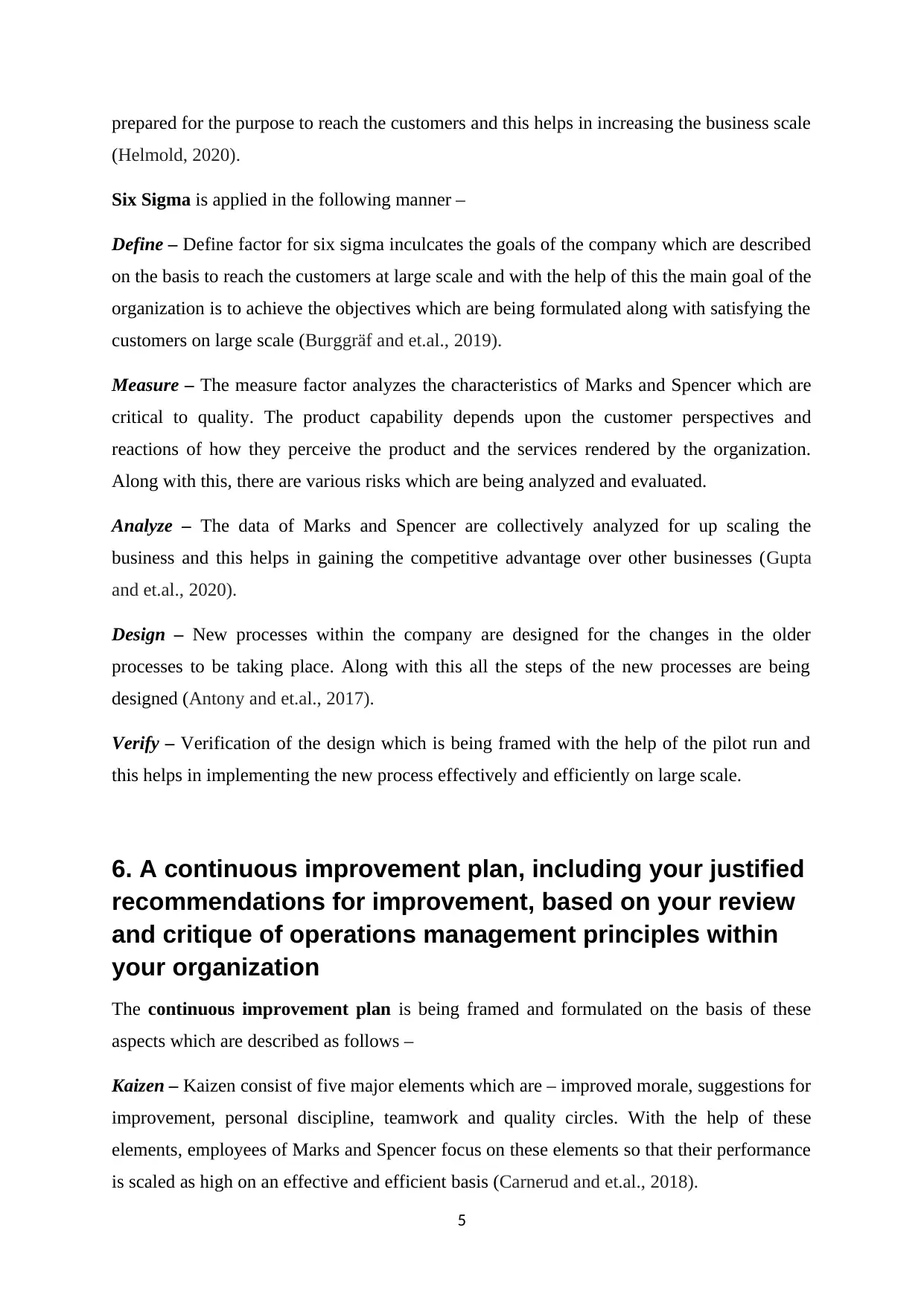
prepared for the purpose to reach the customers and this helps in increasing the business scale
(Helmold, 2020).
Six Sigma is applied in the following manner –
Define – Define factor for six sigma inculcates the goals of the company which are described
on the basis to reach the customers at large scale and with the help of this the main goal of the
organization is to achieve the objectives which are being formulated along with satisfying the
customers on large scale (Burggräf and et.al., 2019).
Measure – The measure factor analyzes the characteristics of Marks and Spencer which are
critical to quality. The product capability depends upon the customer perspectives and
reactions of how they perceive the product and the services rendered by the organization.
Along with this, there are various risks which are being analyzed and evaluated.
Analyze – The data of Marks and Spencer are collectively analyzed for up scaling the
business and this helps in gaining the competitive advantage over other businesses (Gupta
and et.al., 2020).
Design – New processes within the company are designed for the changes in the older
processes to be taking place. Along with this all the steps of the new processes are being
designed (Antony and et.al., 2017).
Verify – Verification of the design which is being framed with the help of the pilot run and
this helps in implementing the new process effectively and efficiently on large scale.
6. A continuous improvement plan, including your justified
recommendations for improvement, based on your review
and critique of operations management principles within
your organization
The continuous improvement plan is being framed and formulated on the basis of these
aspects which are described as follows –
Kaizen – Kaizen consist of five major elements which are – improved morale, suggestions for
improvement, personal discipline, teamwork and quality circles. With the help of these
elements, employees of Marks and Spencer focus on these elements so that their performance
is scaled as high on an effective and efficient basis (Carnerud and et.al., 2018).
5
(Helmold, 2020).
Six Sigma is applied in the following manner –
Define – Define factor for six sigma inculcates the goals of the company which are described
on the basis to reach the customers at large scale and with the help of this the main goal of the
organization is to achieve the objectives which are being formulated along with satisfying the
customers on large scale (Burggräf and et.al., 2019).
Measure – The measure factor analyzes the characteristics of Marks and Spencer which are
critical to quality. The product capability depends upon the customer perspectives and
reactions of how they perceive the product and the services rendered by the organization.
Along with this, there are various risks which are being analyzed and evaluated.
Analyze – The data of Marks and Spencer are collectively analyzed for up scaling the
business and this helps in gaining the competitive advantage over other businesses (Gupta
and et.al., 2020).
Design – New processes within the company are designed for the changes in the older
processes to be taking place. Along with this all the steps of the new processes are being
designed (Antony and et.al., 2017).
Verify – Verification of the design which is being framed with the help of the pilot run and
this helps in implementing the new process effectively and efficiently on large scale.
6. A continuous improvement plan, including your justified
recommendations for improvement, based on your review
and critique of operations management principles within
your organization
The continuous improvement plan is being framed and formulated on the basis of these
aspects which are described as follows –
Kaizen – Kaizen consist of five major elements which are – improved morale, suggestions for
improvement, personal discipline, teamwork and quality circles. With the help of these
elements, employees of Marks and Spencer focus on these elements so that their performance
is scaled as high on an effective and efficient basis (Carnerud and et.al., 2018).
5
⊘ This is a preview!⊘
Do you want full access?
Subscribe today to unlock all pages.

Trusted by 1+ million students worldwide

Pros – Improves teamwork, waste reduction, increases employee satisfaction etc.
Cons – It distorts the entire system of management etc.
Quality Circles – With the help of framing the quality circles the process and the functions of
Marks and Spencer ensure that the products and the services are being produced at business
scale which helps in growing and achieving success overall.
Pros – Improves problem solving ability, enhances employee communication etc.
Cons – Ill time management, lack of management support etc.
Benchmarking – Benchmarking helps in the process of measuring the business which Marks
and Spencer has created over the years by analyzing and evaluating the metrics and practices
which function in the company while comparing them.
Pros – Helps in setting performance expectations, developing standard of work etc (Eisert
and et.al., 2020).
Cons – Fosters mediocrity, does not measures efficiency etc.
Total Quality Management (TQM) - With the help of this approach, Marks and Spencer is
seeking long time success in the market by providing the customers products and services
according to their needs and requirements.
Pros – Helps in increasing profitability and develops higher productivity etc.
Cons – Changes the culture, creativity is discouraged etc.
Supply Chain Management (SCM) – Marks and Spencer’s supply chain management helps
in flow of products and services which are formed by transforming raw materials into the
final products.
Pros – Better at collaborating, improves the cash flow etc.
Cons – Risk of waste in labor force, missed deadlines of work etc (Saberi and et.al., 2019).
Enterprise Resource Planning (ERP) – Resource planning in Marks and Spencer is done
with the help of this software which helps the organization in managing the day – to – day
activities which is being conducted in the business such as accounting, risk management,
supply chain operations, project management etc.
Pros – Improvement in inventory cost, better customer service etc.
6
Cons – It distorts the entire system of management etc.
Quality Circles – With the help of framing the quality circles the process and the functions of
Marks and Spencer ensure that the products and the services are being produced at business
scale which helps in growing and achieving success overall.
Pros – Improves problem solving ability, enhances employee communication etc.
Cons – Ill time management, lack of management support etc.
Benchmarking – Benchmarking helps in the process of measuring the business which Marks
and Spencer has created over the years by analyzing and evaluating the metrics and practices
which function in the company while comparing them.
Pros – Helps in setting performance expectations, developing standard of work etc (Eisert
and et.al., 2020).
Cons – Fosters mediocrity, does not measures efficiency etc.
Total Quality Management (TQM) - With the help of this approach, Marks and Spencer is
seeking long time success in the market by providing the customers products and services
according to their needs and requirements.
Pros – Helps in increasing profitability and develops higher productivity etc.
Cons – Changes the culture, creativity is discouraged etc.
Supply Chain Management (SCM) – Marks and Spencer’s supply chain management helps
in flow of products and services which are formed by transforming raw materials into the
final products.
Pros – Better at collaborating, improves the cash flow etc.
Cons – Risk of waste in labor force, missed deadlines of work etc (Saberi and et.al., 2019).
Enterprise Resource Planning (ERP) – Resource planning in Marks and Spencer is done
with the help of this software which helps the organization in managing the day – to – day
activities which is being conducted in the business such as accounting, risk management,
supply chain operations, project management etc.
Pros – Improvement in inventory cost, better customer service etc.
6
Paraphrase This Document
Need a fresh take? Get an instant paraphrase of this document with our AI Paraphraser
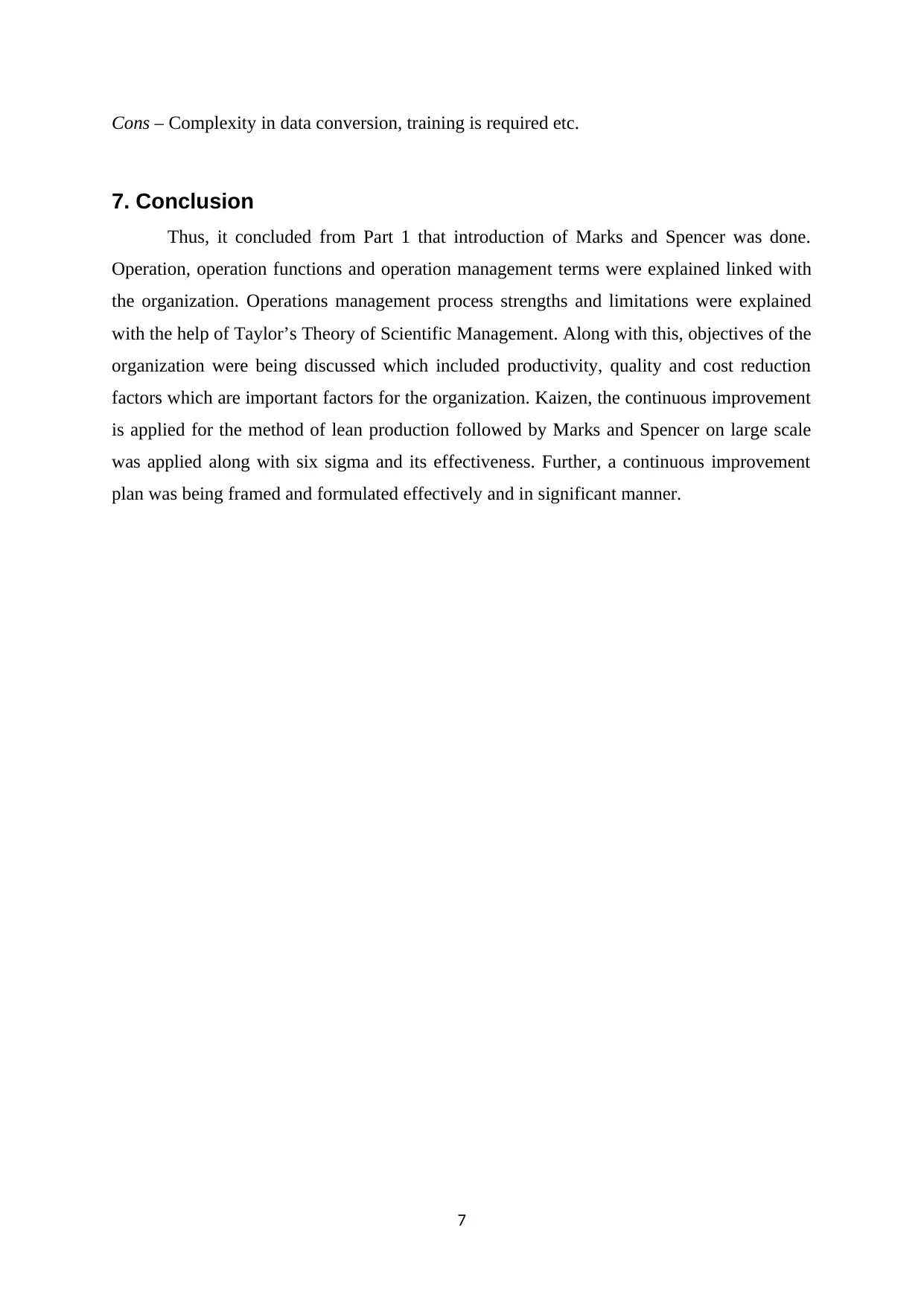
Cons – Complexity in data conversion, training is required etc.
7. Conclusion
Thus, it concluded from Part 1 that introduction of Marks and Spencer was done.
Operation, operation functions and operation management terms were explained linked with
the organization. Operations management process strengths and limitations were explained
with the help of Taylor’s Theory of Scientific Management. Along with this, objectives of the
organization were being discussed which included productivity, quality and cost reduction
factors which are important factors for the organization. Kaizen, the continuous improvement
is applied for the method of lean production followed by Marks and Spencer on large scale
was applied along with six sigma and its effectiveness. Further, a continuous improvement
plan was being framed and formulated effectively and in significant manner.
7
7. Conclusion
Thus, it concluded from Part 1 that introduction of Marks and Spencer was done.
Operation, operation functions and operation management terms were explained linked with
the organization. Operations management process strengths and limitations were explained
with the help of Taylor’s Theory of Scientific Management. Along with this, objectives of the
organization were being discussed which included productivity, quality and cost reduction
factors which are important factors for the organization. Kaizen, the continuous improvement
is applied for the method of lean production followed by Marks and Spencer on large scale
was applied along with six sigma and its effectiveness. Further, a continuous improvement
plan was being framed and formulated effectively and in significant manner.
7
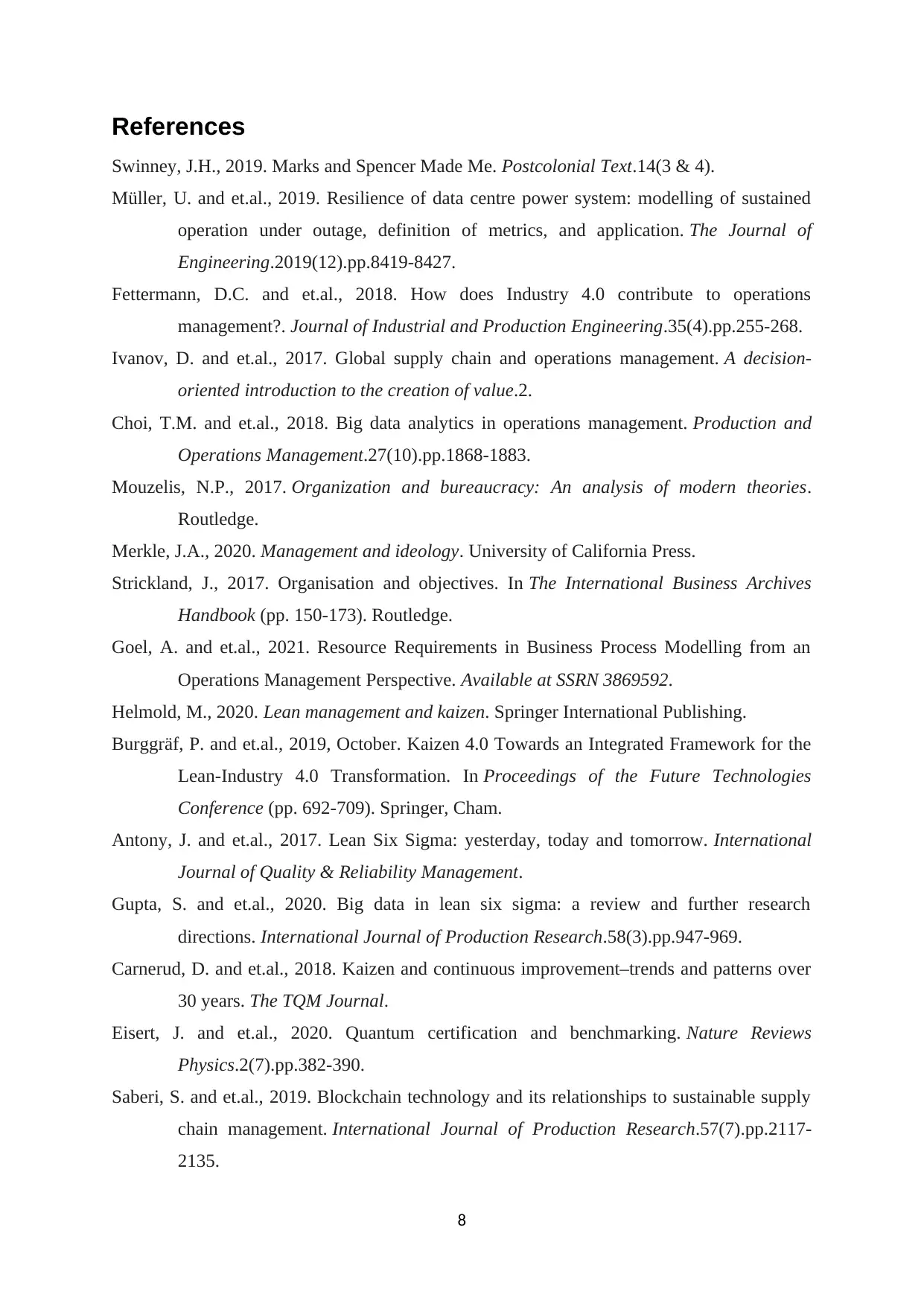
References
Swinney, J.H., 2019. Marks and Spencer Made Me. Postcolonial Text.14(3 & 4).
Müller, U. and et.al., 2019. Resilience of data centre power system: modelling of sustained
operation under outage, definition of metrics, and application. The Journal of
Engineering.2019(12).pp.8419-8427.
Fettermann, D.C. and et.al., 2018. How does Industry 4.0 contribute to operations
management?. Journal of Industrial and Production Engineering.35(4).pp.255-268.
Ivanov, D. and et.al., 2017. Global supply chain and operations management. A decision-
oriented introduction to the creation of value.2.
Choi, T.M. and et.al., 2018. Big data analytics in operations management. Production and
Operations Management.27(10).pp.1868-1883.
Mouzelis, N.P., 2017. Organization and bureaucracy: An analysis of modern theories.
Routledge.
Merkle, J.A., 2020. Management and ideology. University of California Press.
Strickland, J., 2017. Organisation and objectives. In The International Business Archives
Handbook (pp. 150-173). Routledge.
Goel, A. and et.al., 2021. Resource Requirements in Business Process Modelling from an
Operations Management Perspective. Available at SSRN 3869592.
Helmold, M., 2020. Lean management and kaizen. Springer International Publishing.
Burggräf, P. and et.al., 2019, October. Kaizen 4.0 Towards an Integrated Framework for the
Lean-Industry 4.0 Transformation. In Proceedings of the Future Technologies
Conference (pp. 692-709). Springer, Cham.
Antony, J. and et.al., 2017. Lean Six Sigma: yesterday, today and tomorrow. International
Journal of Quality & Reliability Management.
Gupta, S. and et.al., 2020. Big data in lean six sigma: a review and further research
directions. International Journal of Production Research.58(3).pp.947-969.
Carnerud, D. and et.al., 2018. Kaizen and continuous improvement–trends and patterns over
30 years. The TQM Journal.
Eisert, J. and et.al., 2020. Quantum certification and benchmarking. Nature Reviews
Physics.2(7).pp.382-390.
Saberi, S. and et.al., 2019. Blockchain technology and its relationships to sustainable supply
chain management. International Journal of Production Research.57(7).pp.2117-
2135.
8
Swinney, J.H., 2019. Marks and Spencer Made Me. Postcolonial Text.14(3 & 4).
Müller, U. and et.al., 2019. Resilience of data centre power system: modelling of sustained
operation under outage, definition of metrics, and application. The Journal of
Engineering.2019(12).pp.8419-8427.
Fettermann, D.C. and et.al., 2018. How does Industry 4.0 contribute to operations
management?. Journal of Industrial and Production Engineering.35(4).pp.255-268.
Ivanov, D. and et.al., 2017. Global supply chain and operations management. A decision-
oriented introduction to the creation of value.2.
Choi, T.M. and et.al., 2018. Big data analytics in operations management. Production and
Operations Management.27(10).pp.1868-1883.
Mouzelis, N.P., 2017. Organization and bureaucracy: An analysis of modern theories.
Routledge.
Merkle, J.A., 2020. Management and ideology. University of California Press.
Strickland, J., 2017. Organisation and objectives. In The International Business Archives
Handbook (pp. 150-173). Routledge.
Goel, A. and et.al., 2021. Resource Requirements in Business Process Modelling from an
Operations Management Perspective. Available at SSRN 3869592.
Helmold, M., 2020. Lean management and kaizen. Springer International Publishing.
Burggräf, P. and et.al., 2019, October. Kaizen 4.0 Towards an Integrated Framework for the
Lean-Industry 4.0 Transformation. In Proceedings of the Future Technologies
Conference (pp. 692-709). Springer, Cham.
Antony, J. and et.al., 2017. Lean Six Sigma: yesterday, today and tomorrow. International
Journal of Quality & Reliability Management.
Gupta, S. and et.al., 2020. Big data in lean six sigma: a review and further research
directions. International Journal of Production Research.58(3).pp.947-969.
Carnerud, D. and et.al., 2018. Kaizen and continuous improvement–trends and patterns over
30 years. The TQM Journal.
Eisert, J. and et.al., 2020. Quantum certification and benchmarking. Nature Reviews
Physics.2(7).pp.382-390.
Saberi, S. and et.al., 2019. Blockchain technology and its relationships to sustainable supply
chain management. International Journal of Production Research.57(7).pp.2117-
2135.
8
⊘ This is a preview!⊘
Do you want full access?
Subscribe today to unlock all pages.

Trusted by 1+ million students worldwide

Table of Content
Part 2: Project Portfolio
Project Title p
An overview of the case study you have been given p
An explanation of each stage of the PLC that applies to your
selected project, including supporting documentation for each
stage (e.g., business case, the project plan, cost-benefit analysis
and work breakdown structure):
Project initiation p
Project planning p
Project execution p
Project closure p
Analysis of the project methodologies and tools used p
Review and critically evaluate the effectiveness of the PLC in
application to your project using the appropriate theories models
and concepts p
9
Part 2: Project Portfolio
Project Title p
An overview of the case study you have been given p
An explanation of each stage of the PLC that applies to your
selected project, including supporting documentation for each
stage (e.g., business case, the project plan, cost-benefit analysis
and work breakdown structure):
Project initiation p
Project planning p
Project execution p
Project closure p
Analysis of the project methodologies and tools used p
Review and critically evaluate the effectiveness of the PLC in
application to your project using the appropriate theories models
and concepts p
9
Paraphrase This Document
Need a fresh take? Get an instant paraphrase of this document with our AI Paraphraser
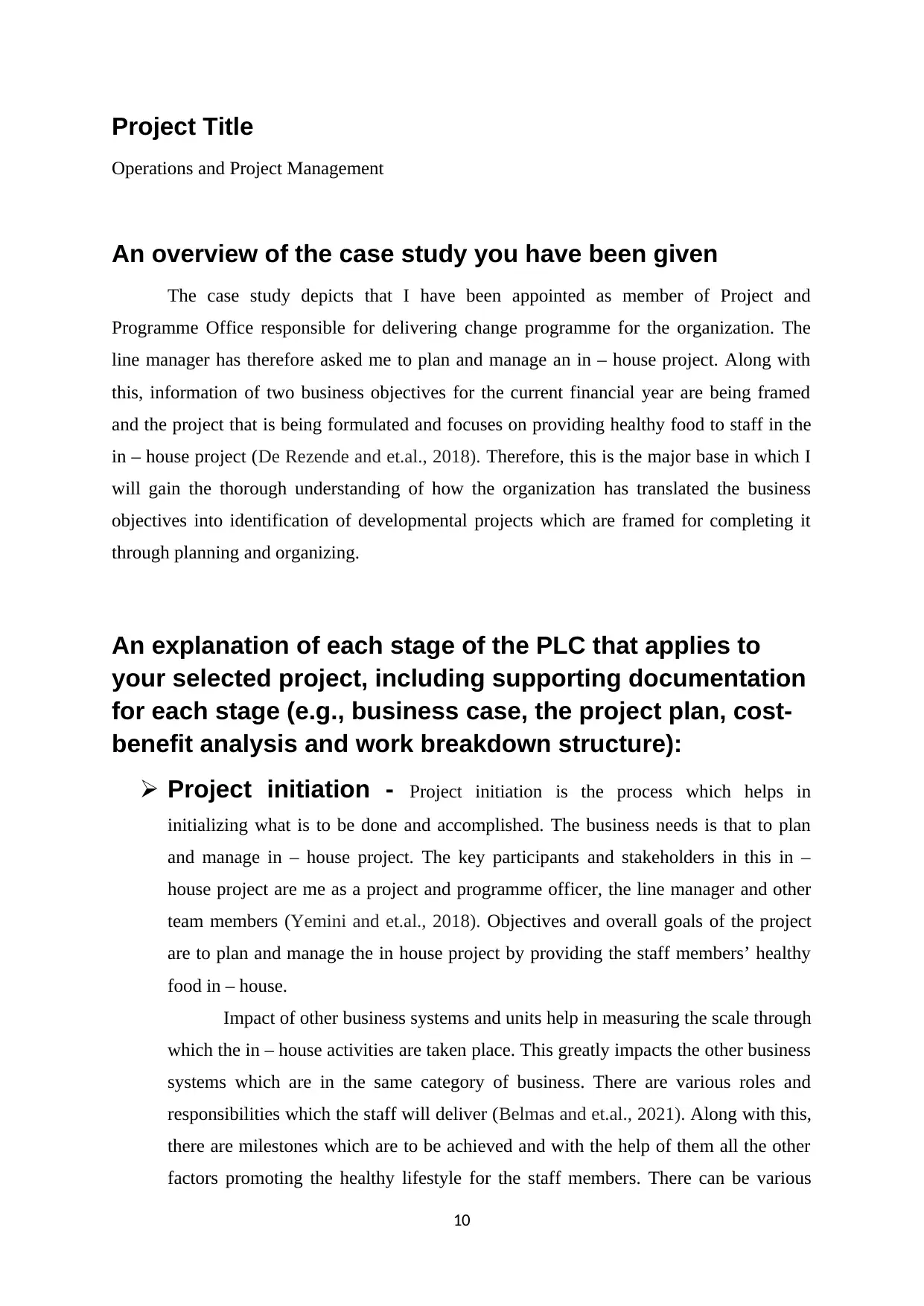
Project Title
Operations and Project Management
An overview of the case study you have been given
The case study depicts that I have been appointed as member of Project and
Programme Office responsible for delivering change programme for the organization. The
line manager has therefore asked me to plan and manage an in – house project. Along with
this, information of two business objectives for the current financial year are being framed
and the project that is being formulated and focuses on providing healthy food to staff in the
in – house project (De Rezende and et.al., 2018). Therefore, this is the major base in which I
will gain the thorough understanding of how the organization has translated the business
objectives into identification of developmental projects which are framed for completing it
through planning and organizing.
An explanation of each stage of the PLC that applies to
your selected project, including supporting documentation
for each stage (e.g., business case, the project plan, cost-
benefit analysis and work breakdown structure):
Project initiation - Project initiation is the process which helps in
initializing what is to be done and accomplished. The business needs is that to plan
and manage in – house project. The key participants and stakeholders in this in –
house project are me as a project and programme officer, the line manager and other
team members (Yemini and et.al., 2018). Objectives and overall goals of the project
are to plan and manage the in house project by providing the staff members’ healthy
food in – house.
Impact of other business systems and units help in measuring the scale through
which the in – house activities are taken place. This greatly impacts the other business
systems which are in the same category of business. There are various roles and
responsibilities which the staff will deliver (Belmas and et.al., 2021). Along with this,
there are milestones which are to be achieved and with the help of them all the other
factors promoting the healthy lifestyle for the staff members. There can be various
10
Operations and Project Management
An overview of the case study you have been given
The case study depicts that I have been appointed as member of Project and
Programme Office responsible for delivering change programme for the organization. The
line manager has therefore asked me to plan and manage an in – house project. Along with
this, information of two business objectives for the current financial year are being framed
and the project that is being formulated and focuses on providing healthy food to staff in the
in – house project (De Rezende and et.al., 2018). Therefore, this is the major base in which I
will gain the thorough understanding of how the organization has translated the business
objectives into identification of developmental projects which are framed for completing it
through planning and organizing.
An explanation of each stage of the PLC that applies to
your selected project, including supporting documentation
for each stage (e.g., business case, the project plan, cost-
benefit analysis and work breakdown structure):
Project initiation - Project initiation is the process which helps in
initializing what is to be done and accomplished. The business needs is that to plan
and manage in – house project. The key participants and stakeholders in this in –
house project are me as a project and programme officer, the line manager and other
team members (Yemini and et.al., 2018). Objectives and overall goals of the project
are to plan and manage the in house project by providing the staff members’ healthy
food in – house.
Impact of other business systems and units help in measuring the scale through
which the in – house activities are taken place. This greatly impacts the other business
systems which are in the same category of business. There are various roles and
responsibilities which the staff will deliver (Belmas and et.al., 2021). Along with this,
there are milestones which are to be achieved and with the help of them all the other
factors promoting the healthy lifestyle for the staff members. There can be various
10

risks while initiating this in – house project which can lack time constraints, excess of
information and data, wrongful information. Success measurement can be observed
with the help of gaining knowledge. And after all these steps the project is approved.
Project planning -
Scope Planning – The in – scope requirements for the project are for cooking the
food in – house on which the project focuses helps in making the providing the staff
members health lifestyle and health food (Sligo and et.al., 2017).
Preparation of the Work Breakdown Structure – The work breakdown structure will
help in facilitating and creating the tasks and sub – tasks to be followed with the
structure on large scale by delegating the roles and responsibilities to the workforce.
Project Schedule Development – All the implementation of the activities are framed
step by step for accomplishing the goals and the tasks that are to be fulfilled.
Resource Planning – With the help of resource planning, at the position of
programme office and for the project, delegation of the authorities and roles will be
provided to the staff members for accomplishing the project tasks (Jünge and et.al.,
2019).
Budget Planning – Cost to be incurred for the project is enunciated which helps in
gaining the financial scale.
Procurement Planning – Subcontracting and focusing on vendors is done for the in –
house project which is being initiated.
Risk Management – Possible risks are analyzed and evaluated on large scale for the
project.
Quality Planning – Assuring that the quality project is the main focus for the in –
house project (Naeem and et.al., 2018).
Communication Planning – Communication strategies are being framed including all
the stakeholders for the project to be completed significantly.
Project execution – In this stage of project lifecycle, actions are taking
place for the in – house project and there are many changes which are being created
for the making the project successful and accomplished. The project deliverables
which are the tangible outputs required for the project facilitate the cooking materials
which are required in the in – house project (Mirza and et.al., 2017). The deliverables
11
information and data, wrongful information. Success measurement can be observed
with the help of gaining knowledge. And after all these steps the project is approved.
Project planning -
Scope Planning – The in – scope requirements for the project are for cooking the
food in – house on which the project focuses helps in making the providing the staff
members health lifestyle and health food (Sligo and et.al., 2017).
Preparation of the Work Breakdown Structure – The work breakdown structure will
help in facilitating and creating the tasks and sub – tasks to be followed with the
structure on large scale by delegating the roles and responsibilities to the workforce.
Project Schedule Development – All the implementation of the activities are framed
step by step for accomplishing the goals and the tasks that are to be fulfilled.
Resource Planning – With the help of resource planning, at the position of
programme office and for the project, delegation of the authorities and roles will be
provided to the staff members for accomplishing the project tasks (Jünge and et.al.,
2019).
Budget Planning – Cost to be incurred for the project is enunciated which helps in
gaining the financial scale.
Procurement Planning – Subcontracting and focusing on vendors is done for the in –
house project which is being initiated.
Risk Management – Possible risks are analyzed and evaluated on large scale for the
project.
Quality Planning – Assuring that the quality project is the main focus for the in –
house project (Naeem and et.al., 2018).
Communication Planning – Communication strategies are being framed including all
the stakeholders for the project to be completed significantly.
Project execution – In this stage of project lifecycle, actions are taking
place for the in – house project and there are many changes which are being created
for the making the project successful and accomplished. The project deliverables
which are the tangible outputs required for the project facilitate the cooking materials
which are required in the in – house project (Mirza and et.al., 2017). The deliverables
11
⊘ This is a preview!⊘
Do you want full access?
Subscribe today to unlock all pages.

Trusted by 1+ million students worldwide
1 out of 23
Related Documents
Your All-in-One AI-Powered Toolkit for Academic Success.
+13062052269
info@desklib.com
Available 24*7 on WhatsApp / Email
![[object Object]](/_next/static/media/star-bottom.7253800d.svg)
Unlock your academic potential
Copyright © 2020–2025 A2Z Services. All Rights Reserved. Developed and managed by ZUCOL.





